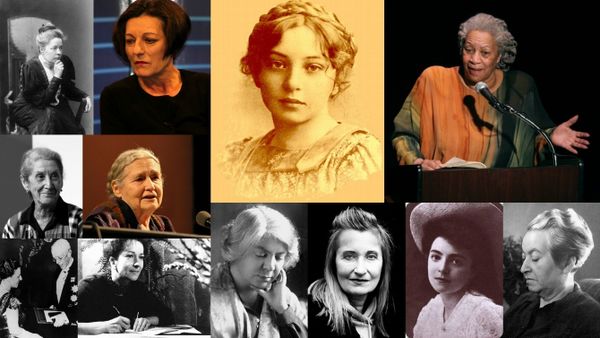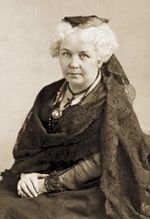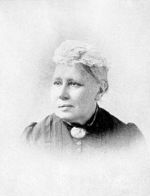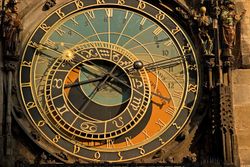Category:Women
|
Women Authorship (Home Page)
Women Authorship -- Scholarship -- Overview Until the end of the 19th century women were barred to enter the academia. They expressed themselves in the arts or in mystical writings (see below). They had to struggle to affirm their right to preach and interpret the Scriptures. Only under very exceptional circumstances a few educated women had the opportunity to contribute as scholars to the field of Jewish, Christian and Islamic Origins. In 1713-52 Swedish poetess Maria Gustava Gyllenstierna translated the works of Josephus into Swedish, from the French edition by Arnauld d'Andilly. In the United States Hannah Adams learned Latin and Greek from the divinity students who boarded with her father in Medfield, MA and published a series of scholarly books in the field, including The History of the Jews from the Destruction of Jerusalem to the Nineteenth Century (1812 Adams), book. In 1816 British author Frances Elizabeth King wrote a survey of women in the Bible. In the 1860s Charlotte Maria Tucker and Anne Mary Perceval in England and Henriette Elizabeth, Madame de Witt in France wrote educational books on Second Temple Judaism. The Woman's Bible (1895-98), edited by Elizabeth Cady Stanton, was the first work authored by women which openly claimed to be a scholarly work, and not a work of fiction or entertainment. Social activist and suffragist Stanton invited more than twenty female Hebrew and Greek scholars to discuss Biblical passages subjugating or omitting women. In those years the first female scholars were active. In the United States Matilda Joslyn Gage and Elizabeth Wormeley Latimer published books on the New Testament and Second Temple Judaism. In England, twin sisters Agnes Smith Lewis and Margaret Dunlop Gibson were accomplished philologists, unofficially affiliated to the University of Cambridge. They traveled to the Middle East where in 1892 they discovered the Codex syrus sinaiticus in the monastery of St. Catherine and catalogued the monastery's extensive collection of Syriac and Arabic manuscripts. In the 1910s, Margaret Elizabeth Sangster and Arnolda Constantia Eliana Gerlings in the Netherlands devoted their skill to the study of women in the Bible and the early Church. In the 1920s and 1930s, Mary Redington Ely Lyman and Olive May Winchester were among the first American women professors in the field of New Testament Studies. Mary Edith Andrews graduated in 1931 from the University of Chicago with a pioneering work on Paul. French poet Marie-Thérèse Gadala published works on her travels in the Middle East and on women in the Bible. American classical scholar Lily Ross Taylor also contributed to the field of Early Christianity. In the 1950s and 1960s, the success of books like Edith Deen's All of the Women of the Bible (1955) and Eugenia Price's The Unique World of Women in Bible Times and Now (1969) signaled that a new generation of female scholars was about to emerge. Argentine specialist of Romance and Hispanic Studies Emma Susana Speratti Piñero, Italian-Argentinian Judaic Studies professor Lea Scazzocchio Sestieri and American writers Barbara Mertz and Ines Noble were among the first women to engage in Qumran Studies. More directly involved in the study of the Scrolls was French specialist Annie Jaubert. Her pioneering studies on the Qumran calendar had a profound impact also on the interpretation of the Gospel chronology of the Last Supper. In Italy archaeologist Margherita Guarducci led the team of specialists who worked at the rediscovery of the ancient necropolis underneath the Vatican where the Tomb of Peter was located, and Klara Kraus Reggiani published her first major contribution to the field of Jewish-Hellenistic Studies. In the 1970s, the presence of women scholars in the field has grown exponentially: Edith Deen, Rosemary Radford Ruether, Phyllis Trible, Pheme Perkins, Elaine H. Pagels, Adela Yarbro Collins in the United States; Annie Jaubert in France; Clara Kraus Reggiani in Italy; Luise Schottroff in Germany; Raija Sollamo in Finland; Margarita M. Elizarova in Russia. In the 1980s, the publication of Elisabeth Schüssler Fiorenza's In Memory of Her (1983) marks a groundbreaking contribution of Feminist Criticism to the study of Christian Origins. Women scholars are particularly active as specialists in in the Bible and early Christian Studies: Elisabeth Moltmann-Wendel in Germany; Pheme Perkins, Carolyn Osiek, Elaine H. Pagels, Phyllis Trible, Barbara E. Bowe, Adela Yarbro Collins, Paula Fredriksen and Amy-Jill Levine in the United States; Vilma Gozzini in Italy; France Quéré in France. Many also focus on Judaic Studies and Second Temple Judaism: Bernadette J. Brooten, Martha Himmelfarb, Carol A. Newsom and Gwendolyn B. Sayler in the United States; Jacqueline Genot-Bismuth in France; Tessa Rajak and Margaret Barker in England; Marie-Theres Wacker in Germany; Clara Kraus Reggiani and Liliana Rosso Ubigli in Italy; Bilhah Nitzan, Devorah Dimant and Rachel Hachlili in Israel; María Victoria Spottorno Díaz-Caro in Spain. At the turn of the 21th century, women are now a consolidated presence in international scholarship. While maintaining a special emphasis in women's studies and feminist interpretation, their contribution covers all fields of Second Temple Studies.
Women Authorship -- Literature & the Arts -- Overview Until the end of the 19th century women were not allowed to have any public role in the academia. Educated women contributed to the field of Jewish and Christian Origins since the Renaissance as poets, playwrights, artists and composers. The first female writer to compose poetry on biblical subjects was the wife of Piero de' Medici, Lucrezia Tornabuoni, around 1475. At the ned of the 16th century, beginning of the 17th century, painters Fede Galizia and Artemisia Gentileschi also revisited "biblical" subjects from the Second Temple period. The Tragedy of Mariam, the Fair Queen of Jewry (1604) by Elizabeth Cary was the first original tragedy by a woman written in English and the earliest English handling of the story of Herod and Mariamne, based on Josephus. Great sensation caused in 1642 the publication of the Lettres de Bérénice à Titus by Madeleine de Scudéry; the French novelist reinvented the characters of Titus and Berenice as fictional protagonists of one of the most intriguing love story of antiquity. In the 17th century a tradition of visionary and mystical works written by women also began to develop, by authors such as Maria de Agreda in Spain, Jeanne-Marie Guyon in France, and Jane Lead in England. In the 18th century, plays based on Second Temple Jewish subjects were composed in Italy by Francesca Manzoni Giusti and in England by Mary Latter and Mary Eleanor Bowes Strathmore. Elisabeth-Claude Jacquet de La Guerre in France, Maria Margherita Grimani]] in Austria and Maria Rosa Coccia at Rome authored oratorios on similar subjects; in England poetess Mary Collyer translated the poetry of Salomon Gessner's Der Tod Abels and Friedrich Gottlieb Klopstock's Der Messias. At the beginning of the 19th century, women began to be more actively and more commonly involved in publishing as authors of fictional or semi-fictional works of ancient history. Susanna Moodie and Chistian Isobel Johnstone in Scotland, Harriet Martineau and Annie Molyneux Peploe in England, Sarah Pogson Smith in the United States, and Delphine de Girardin in France were among the most significant representatives of their generation. Great popularity had also the visionary accounts of Anne Catherine Emmerich who like Maria de Agreda before her, focused on the lives of Jesus and Mary of Nazareth. In the second half of the 19th century, historical novels of biblical subject became a very popular literary genre and a much welcomed opportunity for educated women. Among the most popular authors were The invention of cinema offered women a new possibility of expression. Alice Guy-Blaché one of the pioneers of early cinema shot one of the first Jesus movies: La naissance, la vie et la mort de N.-S. Jésus-Christ (The Birth, the Life and the Death of Christ / 1906 Guy-Blaché), film. The Poor Student (1918) by Elma Ehrlich Levinger is one of the first examples of educational Jewish plays produced in the United States. Dear and Glorious Physician, a novel by Taylor Caldwell on Luke, was a celebrated bestsellers. In 1958 Wine of Morning, a biblical movie focusing on the character of Barabbas, directed in 1955 by Katherine Stenholm, was selected to represent the United States at the International Film Festival in Cannes, France. The Bronze Bow (1961) by Elizabeth George Speare was one of the top children's novel of the century. A Love Divine (1996) is a novel by Alexandra Ripley.
Women Authorship -- Highlights
|
Women Authorship : 2020s -- 2010s -- 2000s -- 1990s -- 1980s -- 1970s -- 1960s -- 1950s -- 1940s -- 1930s -- 1920s -- 1910s -- 1900s -- 1850s -- 1800s -- 1700s -- 1600s -- 1500s -- 1400s -- Home Timeline : 2020s -- 2010s -- 2000s -- 1990s -- 1980s -- 1970s -- 1960s -- 1950s -- 1940s -- 1930s -- 1920s -- 1910s -- 1900s -- 1850s -- 1800s -- 1700s -- 1600s -- 1500s -- 1450s -- Medieval -- Home
Women Authorship : English -- French -- German -- Italian -- Spanish -/- Afrikaans -- Albanian -- Catalan -- Chinese -- Croatian -- Czech -- Danish -- Dutch -- Filipino -- Greek -- Hebrew -- Hungarian -- Icelandic -- Japanese -- Latin -- Norwegian -- Polish -- Portuguese -- Romanian -- Russian -- Serbian -- Slovenian -- Spanish -- Swedish -- Welsh -- Yiddish
Albanian - American - Argentine - Armenian - Australian - Austrian - Belarusian - Belgian - Bolivian - Brazilian - British - Bulgarian - Canadian - Chilean - Chinese - Colombian - Croatian - Czech - Danish - Dutch - Estonian - Ethiopian - Finnish - French - German - Greek - Hungarian - Icelandic - Iranian - Irish - Israeli - Italian - Japanese - Jewish - Korean - Latvian - Lebanese - Lithuanian - Maltese - Mexican - Norwegian - Peruvian - Polish - Portuguese - Puerto Rican - Romanian - Russian - Scottish - Serbian - Slovak - Slovenian - South African - Spanish - Swedish - Swiss - Ukrainian - Uruguayan - Welsh - Women
|
Subcategories
This category has the following 30 subcategories, out of 30 total.
1
- 1864 Bellincioni, Gemma (singer) ITA
- 1868 Wittich, Marie (singer) DEU
- 1869 Breval, Lucienne (singer) CHE
- 1870 Eysoldt, Gertrud (actor) DEU
- 1871 Fremstad, Olive (singer) SWE USA
- 1872 Krushelnytska, Solomiya (1872) UKR
- 1874 Cavalieri, Lina (singer) ITA
- 1874 Doenges, Paula (singer) DEU
- 1874 Garden, Mary (singer, dancer) GBR
- 1874 Verhunk, Fanchette (singer) SVN
- 1880 * Overton-Walker, Aida (dancer, choreographer) USA
- 1885 Bara, Theda (actress) USA
- 1885 Gauntier, Gene (actor) USA
- 1885 Lepanto, Vittoria (actor) ITA
- 1886 Hollister, Alice (actor) USA
- 1886 Napierkowska, Stacia (actor, dancer) FRA
- 1891 * Hurston, Zora Neale (novelist) USA
- 1898 Allen, Diana (actor) SWE
- 1904 Walker, Aurora (actor) MEX
- 1908 Davis, Bette (actor) USA
- 1908 Magnani, Anna (actor) ITA
- 1917 Stenholm, Katherine (director) USA
- 1926 Monroe, Marilyn (actor) USA
- 1926 Rysanek, Leonie (singer) AUT
- 1934 Loren, Sophia (actor) ITA
- 1950 * Grimes, Nikki (novelist, poet) USA
- 1960 * Vertova, Caterina (actor) ITA
- 1968 Cucinotta, Maria Grazia (actor) ITA
- 1981 Anastasio, Alexia (actor, director) USA
- 1984 * Durlo, Gabriela (actor) BRA
Pages in category "Women"
The following 200 pages are in this category, out of 398 total.
(previous page) (next page)- Women Authorship (1450s)
- Women Authorship (1500s)
- Women Authorship (1600s)
- Women Authorship (1700s)
- Women Authorship (1800s)
- Women Authorship (1850s)
- Women Authorship (1900s)
- Women Authorship (1910s)
- Women Authorship (1920s)
- Women Authorship (1930s)
- Women Authorship (1940s)
- Women Authorship (1950s)
- Women Authorship (1960s)
- Women Authorship (1970s)
- Women Authorship (1980s)
- Women Authorship (1990s)
- Women Authorship (2000s)
- Women Authorship (2010s)
*
1
- Lucrezia Tornabuoni (F / Italy, 1425-1482), poet
- Lavinia Fontana (F / Italy, 1552-1614), artist
- Fede Galizia (F / Italy, 1578-1630), artist
- Elizabeth Cary (F / Britain, 1585-1639), playwright
- Artemisia Gentileschi (F / Italy, 1593-1656), artist
- Maria de Agreda (F / Spain, 1602-1665), visionary
- Madeleine de Scudéry (F / France, 1607-1701), novelist
- Margaret Fell (F / Britain, 1614-1702), Quaker leader
- Jane Lead (F / Britain, 1623-1704), visionary
- Jeanne-Marie Guyon (F / France, 1648-1717), mystic
- Sophia Elisabet Brenner (F / Sweden, 1659-1730), poet
- Angiola Teresa Muratori-Scannabecchi (F / Italy, 1662-1708), composer
- Elisabeth-Claude Jacquet de La Guerre (F / France, 1665-1729), composer
- Maria Gustava Gyllenstierna (F / Sweden, 1672-1737), scholar, translator
- Maria Margherita Grimani (F / Italy, 18th cent.), composer
- Francesca Manzoni Giusti (F / Italy, 1710-1743), playwright
- Mary Collyer (F / Britain, 1716-1762), poet, translator
- Mary Latter (F / Britain, 1722-1777), playwright
- Mary Eleanor Bowes Strathmore (F / Britain, 1749-1800), playwright
- Hannah Adams (F / United States, 1755-1831), scholar
- Frances Elizabeth King (F / Britain, 1757-1821), author
- Maria Rosa Coccia (F / Italy, 1759-1833), composer
- Mrs E.M. Foster (F / Britain, 18th-19th cent.), novelist
- Anne Catherine Emmerich (F / Germany, 1774-1824), visionary
- Sarah Pogson Smith (F / United States, 1774-1870), novelist
- Chistian Isobel Johnstone (F / Britain, 1781-1857), novelist
- Anne Mary Perceval (F / Britain, 1790-1876), scholar
- Auguste Crelinger (F / Germany, 1795-1865), actor
- Jane Margaret Strickland (F / Britain, 1800-1888), novelist
- Harriet Martineau (F / Britain, 1802-1876), novelist
- Susanna Moodie (F / Britain, 1803-1885), novelist
- Delphine de Girardin (M / France, 1804-1855), playwright
- Elizabeth Harriet Siddons Mair (F / Britain, 1805-1877), novelist
- Annie Molyneux Peploe (F / Britain, 1805-1880), novelist
- Elizabeth Cady Stanton (F / United States, 1815-1902), scholar
- Grace Aguilar
- Henriette Elizabeth, Madame de Witt (F / France, 1820-1908), scholar
- Charlotte Maria Tucker (F / Britain, 1821-1893), novelist
- Elizabeth Wormeley Latimer (1822-1904), British-American scholar
- Charlotte Mary Yonge (F / Britain, 1823-1901), novelist
- Matilda Joslyn Gage (F / United States, 1826-1898), scholar
- Ellen G. White (F / United States, 1827-1915), theologian
- Elizabeth Rundle Charles (F / Britain, 1828-1896), novelist
- Margaret Elizabeth Sangster (F / United States, 1838-1912), scholar
- Clarisse Bader (F / France, 1840-1902), scholar
- Minnie Dessau Louis (F / United States, 1841-1922), poet
- Agnes Smith Lewis (F / Britain, 1843-1926), scholar
- Elizabeth Stuart Phelps (F / United States, 1844-1911), novelist
- Ella Ferris Pell (F / United States, 1846-1922), artist
- Marthe Duvivier (F / France, 1850-1933), singer
- M.E. Bewsher (F / Britain, 19th cent.), novelist
- Fanny Alricks Shugert (F / United States, 19th cent.), novelist
- Fidès Devriès (F / France, 1852-1941), singer
- Mathilda Roos (F / Sweden, 1852-1908), novelist
- Katharine Pearson Woods (F / United States, 1853-1923), novelist
- Elisa Frandin (F / Finland, 1854-1911), singer
- Lina Munte (F / France, 1854-1909), actor
- Marie Corelli (F / Britain, 1855-1924), novelist
- Gregoria Urbina y Miranda
- Emma Calvé (F /France, 1858-1942), singers
- Selma Lagerlöf (F / Sweden, 1858-1940), novelist
- Florence Morse Kingsley (F / United States, 1859-1937), novelist
- Medea Borelli (F / Italy, 1860-1924), singer
- Lillian Langdon (F / United States, 1860-1943), actor
- Amélie Rives Troubetzkoy (F / United States, 1863-1945), playwright
- Annie Russell Marble (F / United States, 1864-1936), scholar
- Emily P. Weaver (F / Canada, 1865-1943), novelist
- Bernie Babcock (F / United States, 1868-1962), novelist
- Caroline Dale Snedeker (F / United States, 1871-1956), novelist
- Edith Olivier (M / Britain, 1872-1948), novelist
- Alice Guy-Blaché (F / France, 1873-1968), film director
- Renée Carl (F / France, 1875-1954), actress
- Arnolda Constantia Eliana Gerlings (F / Netherlands, 1875-1942), Dutch scholar
- Aino Ackté (F / Finland, 1876-1944), singer
- Gertud von Le Fort (F / Germany, 1876-1971), novelist
- Emma Dessau-Goitein (F / Germany, Italy, 1877-1968), artist
- Helen Tracy Lowe-Porter (F / United States, 1877-1963), translator
- Emmy Destinn (F / Czechia, 1878-1930), singer
- Florence Wilkinson Evans (F / United States, 1878-...), playwright
- Elizabeth Jane Miller (F / United States, 1878-1961), novelist
- Constance Crawley (F / Britain, 1879–1919), actor
- Alice Guszalewicz (F / Hungary, 1879-1940), singer
- Alla Nazimova (F / Russia, United States, 1879-1945), actor
- Tilla Durieux (F / Austria, 1880-1971), actor
- Olive May Winchester (F / United States, 1880-1947), scholar
- Marie-Thérèse Gadala
- Asta Nielsen (F / Denmark, 1881–1972), actor
- Anita Trueman Pickett (1881-1960), novelist
- Sara Bard Field (1882-1974), poet
- 1883 Leonidoff, Ileana (actor) RUS
- Amy Morris Lillie (1883-1967), novelist
- Theda Bara (F / United States, 1885-1955), actor, dancer
- Tamara Karsarvina (F / Russia, 1885-1978), dancer
- Helda Doolittle (1886-1961), novelist
- Florence Lawrence (F / United States, 1886-1938), actor
- Lily Ross Taylor (1886-1969), scholar
- Elma Ehrlich Levinger (1887-1958), playwright
- Mary Redington Ely Lyman (1887-1975), scholar
- Diana Karenne (F / Poland, 1888-1940), actor
- Florence LaBadie (F / United States, 1888-1917), actress
- Minerva Teichert (1888-1976), American artist
- Agnes Sligh Turnbull (1888-1982), novelist
- Maria Ventura (F / Romania, France, 1888-1954), actor
- Zofia Kossak (M / Poland, 1889-1968), novelist
- Geraldine Dorothy Cummins (1890-1969), visionary
- Dulcie Deamer (F / Australia, 1890-1972), novelist
- Bessie Eyton (F / United States, 1890-1965), actress
- Gertrude McCoy (F / United States, 1890-1967), actress
- Henny Porten (F / Germany, 1890-1960), actress
- Anna Belle Safier (F / United States, 20th cent.), composer
- Ursula Bloom (F / Britain, 1892-1984), novelist
- Leda Gys / Gisella Lombardi (F / Italy, 1892-1957), actress
- Katherine Binney Shippen (1892-1980), novelist
- Göta Ljungberg (F / Sweden, 1893-1955), singer
- Dorothy L. Sayers (F / Britain, 1893-1957), playwright
- Mary Helm Clarke (1895-1968), novelist
- Daphne Mayo (F / Australia, 1895-1982), artist
- Grace Meyers Petitclerc
- Gladys Malvern (F / United States, 1897-1962), novelist
- Maria Valtorta (F / Italy, 1897-1961), visionary
- Lydia May Glover Deseo (F / United States, 1898-...), playwright
- Gloria Swanson (F / United States, 1899-1983), actor
- Taylor Caldwell (F / Britain, United States, 1900-1985), novelist
- Elizabeth Goudge (F / Britain, 1900-1984), novelist
- Mary Edith Andrews
- Catherine Christian (F / Britain, 1901-1985), novelist
- Jacqueline Logan (F / United States, 1901-1983), actor
- Laurene Chinn (F / United States, 1902-1978), novelist
- Margherita Guarducci (F / Italy, 1902-1999), scholar
- Mafalda Pavia (F / Italy, 1902-1985), nonfiction writer
- Norah Lofts (F / Britain, 1904-1983), novelist
- Dorothy Clarke Wilson (1904-2003), novelist & playwright
- Edith Deen (F / United States, 1905–1994), scholar
- Medea de Novara (F / Liechtenstein, Mexico, 1905-2001), actor, scriptwriter
- Grete Weil (F / Germany, 1906-1999), novelist
- Esther Kellner (F / United States, 1908-1998), novelist
- Adriana Lamar (F / Mexico, 1908-1946), actor
- Elizabeth George Speare (F / United States, 1908-1994), novelist
- Henrietta Buckmaster (F / United States, 1909-1983), novelist
- Margita Figuli (F / Slovakia, 1909-1995), novelist
- Gladys Schmitt (F / United States, 1909-1972), novelist
- Marjorie Holmes (F / United States, 1910-2002), novelist
- Gertrud Fussenegger (F / Austria, 1912-2009), novelist, librettist
- Annie Jaubert (F / France, 1912-1980), scholar
- Lucetta Mowry (F / United States, 1913-2004), scholar
- Lea Scazzocchio Sestieri (F / Italy, 1913-2018), scholar
- Klavdia B. Starkova (F / Russia, 1915-2000), scholar
- Patricia McGerr (F / United States, 1917-1985), novelist
- Rita Hayworth (F / United States, 1918-1987), actress, dancer
- Madeleine L'Engle (F / United States, 1918-2007), novelist
- Muriel McCormac (F / United States, 1918-2000), actress
- Isidora Aguirre (F / Chile, 1919-2011), playwright
- Clara Kraus Reggiani (F / Italy, 1919-2015), scholar
- Emma Susana Speratti Piñero (F / Argentina, 1919-1990), author
- Yvonne De Carlo (F / Canada, United States, 1922-2007), actor
- Roberta Kells Dorr (F / United States, 1922-2010), novelist
- Iris Noble (F / Canada, United States, 1922-1986), nonfiction writer
- Ellen Whitman Bynum (F / United States, 1923-2017), novelist
- Siobhan McKenna (F / Ireland, 1923-1986), actor
- Irena Narell (F / United States, 1923-2004), novelist
- Gloria Howe Bremkamp (F / Unites States, 1924-1999), novelist
- Miriam Chaikin (F / United States, 1924-2015), novelist
- Maria Grazia Mara (F / Italy, 1924-2019), scholar
- Maria Regina Pisa (F / Austria, 1925-2001), novelist
- Elisabeth Moltmann-Wendel (M / Germany, 1926-2016), scholar
- Isabel Quigly (F / Britain, 1926-2018), translator
- Maria Grazia Siliato (F / Italy, 1926-2018), novelist
- Cecil Bødker (F / Denmark, 1927-2020), novelist
- Marianne Fredriksson (F / Sweden, 1927-2007), novelist
- Rosemary Haughton (F / Britain, United States, 1927), novelist
- Barbara Mertz (F / United States, 1927-2013), novelist
- Gloria D. Miklowitz (F / United States, 1927-2015), novelist
- Carmen Sevilla (F / Spain, 1930), actor
- Dolores Cannon (F / United States, 1931-2014), visionary
- Jeanne Champion (F / France, 1931), novelist
- Vilma Gozzini (b.1931), Italian scholar
- Barbara Cohen (F / United States, 1932-1992), novelist







